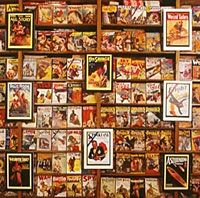 Now would be a good time to win the lottery.
Now would be a good time to win the lottery.
If you haven’t checked it out, head over to Adventure House and browse through the Frank M. Robinson auctions that have gotten under way recently.
You can pick up a complete run of Adventure pulps — all 753 pieces in fine condition — for a starting bid of $10,000. For the same starting bid, you might win a nearly complete run of The Blue Book Magazine — 593 pieces, including a number of early stories of Edgar Rice Burroughs.
You’ll need to deeper pockets to get in on the action to win a complete set of Weird Tales. The current bid is $50,000.
And there are plenty of single issue treasures to be had, too.
I’m sorry to see Mr. Robinson disposing of his collection, but at some point, I suppose, it’s time to let others enjoy the fruits of your efforts. It’s great that pulp fans have a chance at these gems.
But in another way, it’s sad that there isn’t another option for preserving an historic pulp collection such as Mr. Robinson’s, while still providing him with the same compensation he will get from the auction.
In my ideal pulp world, there would be a non-profit foundation whose goal would be to collect, preserve and make available to the public the tremendous bulk of fiction and artwork that was the pulp magazines. (This would be where that lottery win would come in very nicely.)
I’m sure one concern that Mr. Robinson had (and which has also been discussed on various pulp newsgroups at times) was what would become of his pulp collection when he dies. Better he should sell it now, than, as in fabled stories, it end up being considered of little worth by his executors and heaved into a trash bin.
A well-endowed pulp preservation foundation could step in and purchase the collection. But a not-so-well-funded one would still be available to accept tax-deductible donations of pulp collections large and small. Making sure that those vintage magazines that we love would be available for generations to discover and enjoy.
I would want to see such an organization have these goals:
- Make available the pulps in its collection for study and research, as well as enjoyment. This could be both physically and digitally. For pulps before the 1923 U.S. copyright demarcation, make them available online through an electronic library. For those still under copyright, they would be available at the foundation offices.
- Work to preserve these fragile magazines for generations to come. (Which would probably entail duplicate copies: one for preservation, another for public use, and one for digitalization.)
- Collect and preserve pulp-related material, including artwork, promotional material, papers, books, interviews with surviving pulpsters, etc.
- Promote pulp magazines and their history through exhibits, lectures and other forms of education and outreach.
What I would hate to see is an organization keeping these materials hidden away under the excuse of preserving them.
In the meantime, I hope that Mr. Robinson’s collection goes to pulp fans for safekeeping until someday it can find a home at the pulp foundation.
Ah, the stuff of lottery dreams.

